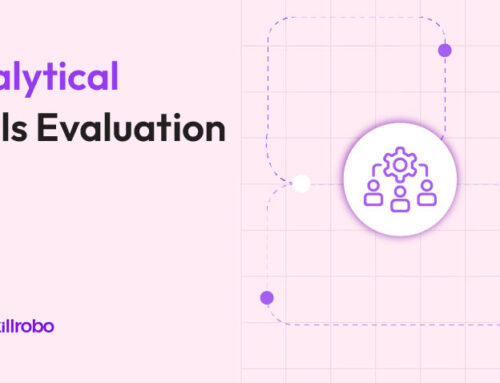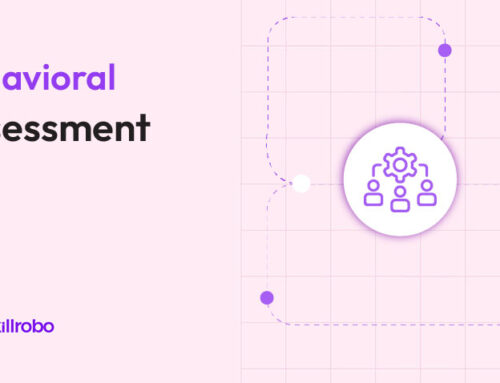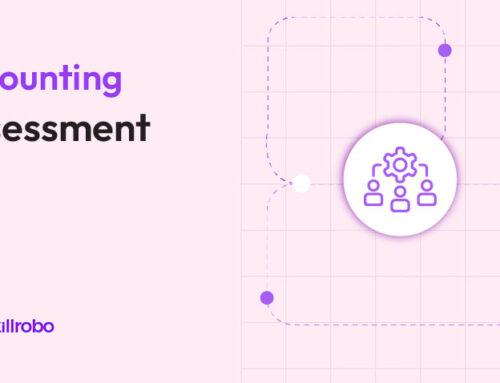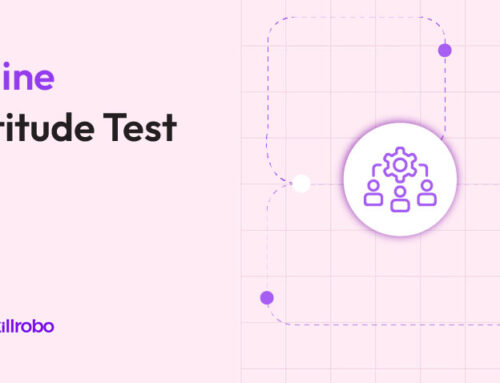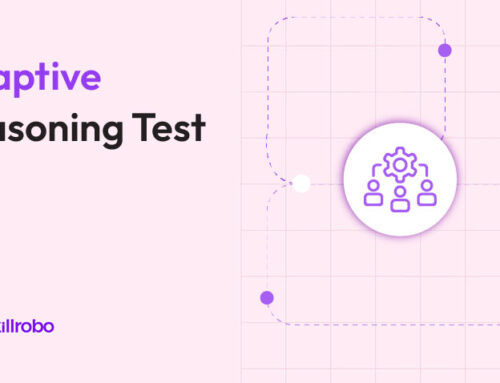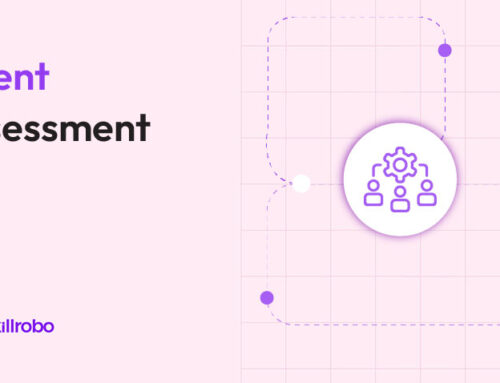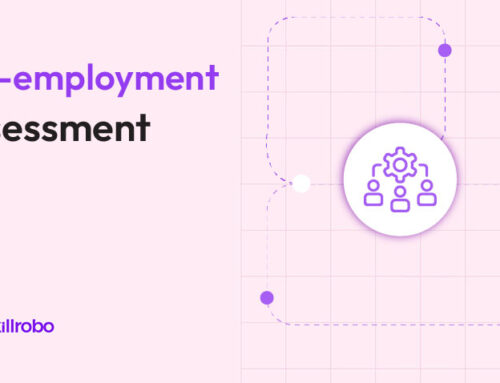Table of Contents
- Key Takeaways
- Why Post Training Assessment Matters
- What is a Post Training Assessment?
- Components of an Effective Post-Training Assessment
- 25 Post-Training Assessment Questions
- Benefits of Pre and Post-Training Assessments
- Digital Tools That Support Assessment
- Skillrobo for Post Training Assessments
- Final Thoughts
Related articles
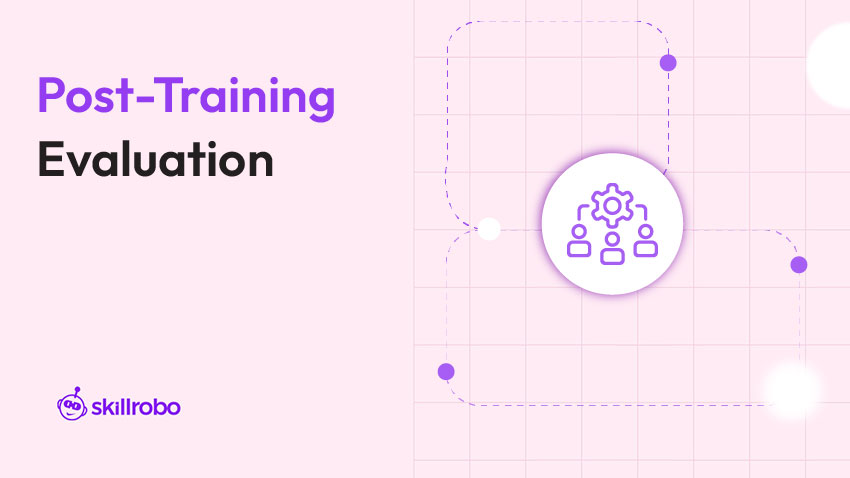
Key Takeaways
- A post-training assessment evaluates the effectiveness of learning programs by measuring knowledge retention and application.
- Using a post-training assessment form helps standardize feedback collection and identify improvement areas.
- Thoughtfully crafted post-training assessment questions provide actionable data on content clarity, relevance, and engagement.
- Combining pre- and post-training assessments offers measurable insights into learning progress and ROI.
- Modern learning and development software tools streamline assessment distribution, scoring, and analytics.
Why Post Training Assessment Matters
A post-training assessment is essential for measuring whether knowledge was retained, understood, and applied, not just delivered. It helps L&D teams identify what worked, what didn't, and how to improve future sessions. In a world of constant upskilling, relying on assumptions is risky. Using structured methods like online employee skill assessment tools provides clear insight into training effectiveness and learning ROI.
In this blog, we'll explore how to design impactful post-training assessments and use them to drive meaningful learning outcomes.
What is a Post Training Assessment?
A post-training assessment is a structured evaluation conducted after a training session to measure how well participants have understood and retained the material. It helps determine if learning objectives were met and whether employees are ready to apply new skills on the job.
These assessments can take many forms—quizzes, open-ended reflections, real-world simulations, or surveys—and are often integrated into modern L&D platforms.
When managed through a tool like employee skills assessment software, assessments become easier to deploy, track, and analyze. Using learning and development assessments, teams can collect real-time performance data, compare pre- and post-training results, and continuously improve training effectiveness.
Components of an Effective Post-Training Assessment
A well-rounded post-training assessment doesn't just test for short-term knowledge—it evaluates comprehension, confidence, behavioral impact, and long-term retention. Each component plays a key role in determining whether the training delivered real value. For L&D teams aiming to maximize ROI and measure outcomes accurately, a multi-layered approach is essential.
Here are the key components that make a post-training evaluation meaningful and actionable:
1. Knowledge Testing
This is the foundational layer of assessment. Through quizzes, case studies, or scenario-based exercises, you measure whether learners have absorbed core concepts and can apply them. Digital platforms that offer online skill assessment tools make this process faster and more consistent, allowing teams to instantly identify knowledge gaps.
2. Feedback Collection
Using a structured post-training assessment questionnaire, L&D teams can gather direct learner input on training effectiveness. This includes content clarity, relevance, delivery style, and perceived usefulness. The feedback helps refine future sessions and ensures the training stays learner-centric.
3. Behavioral Evaluation
Training isn't complete until knowledge translates into on-the-job behavior. That's where manager feedback, peer reviews, and 360-degree evaluations come in. These tools help assess whether employees are applying new skills in real-world situations, critical for measuring the true impact of training.
4. Follow-Up Assessment
Learning decay is real. That's why a post-training evaluation shouldn't end the moment training does. Conducting follow-up assessments 30–60 days later helps gauge long-term retention and reinforcement needs. Platforms with built-in AI-based skills assessment and analysis learning and development assessments support ongoing evaluation to maintain skill sharpness over time.
25 Post-Training Assessment Questions
Effective post-training assessment questions go beyond surface-level feedback like "Did you enjoy the training?" Instead, they explore how much learners absorbed, how confident they feel applying new knowledge, and whether the training aligned with their role expectations. These questions help L&D teams uncover both the strengths and blind spots of their learning programs, making the assessment a valuable improvement tool, not just a checkbox.
- What were the three most valuable things you learned?
- How confident do you feel applying this knowledge in your role?
- Were there topics that needed more depth or clarity?
- How engaging was the delivery format?
- Do you need additional resources to apply what you learned?
- What part of the training was most relevant to your daily work?
- Was the content presented at the right level of difficulty?
- How would you rate the trainer/facilitator's effectiveness?
- Were the learning objectives clearly communicated at the start?
- Did the training meet your personal learning goals?
- How likely are you to recommend this training to a colleague?
- Which topics, if any, felt repetitive or unnecessary?
- Were there enough opportunities to ask questions or interact?
- How useful were the training materials (slides, handouts, etc.)?
- Did the training include enough real-world examples or scenarios?
- Was the pacing of the session appropriate for the topic?
- What improvements would you suggest for future sessions?
- Did you experience any technical issues during the training?
- How well did the training align with your role responsibilities?
- Do you feel this training will help you perform better at work?
- Would you be interested in follow-up training on this topic?
- Were there any knowledge checks or assessments during the training?
- Did you find the post-training assessment useful and relevant?
- What additional topics would you like to see covered in future sessions?
- How do you plan to apply what you've learned in your work?
You can incorporate these into a structured post-training assessment form or automate them using customized employee skill assessment tools that allow for quick feedback collection and real-time analysis.
Benefits of Pre and Post-Training Assessments
Combining pre and post-training assessments enables organizations to measure training impact more accurately. The pre-assessment sets the foundation by capturing baseline knowledge, while the post-assessment quantifies learning gained. This approach ensures that training outcomes are not only visible but also actionable.
Here's how this pairing adds value:
1. Demonstrates Learning Progress
Pre-training scores show starting points, while post-training results highlight growth. This evidence-based comparison gives stakeholders clarity on learner improvement and helps identify who may need additional support.
2. Supports Data-Driven Content Improvement
If post-assessment scores are lower in certain areas, it may signal that the topic was too complex or not explained well. Platforms that support adaptive difficulty levels in training assessments help ensure each learner receives content suited to their ability, improving outcomes.
3. Pinpoints Areas for Additional Coaching
Identifying consistently low scores across cohorts can inform coaching programs or refresher sessions. This reinforces learning and reduces skill decay over time.
4. Strengthens Reporting and Decision Making
This assessment pairing provides reliable data to evaluate training investments and performance impact. For organizations managing global teams, cloud-based learning evaluations make it easy to scale assessments while maintaining consistency.
Digital Tools That Support Assessment
To effectively scale evaluations across departments and geographies, organizations need more than just spreadsheets and manual surveys. Modern learning and development management software plays a critical role in streamlining how assessments are created, delivered, analyzed, and acted upon. These platforms reduce administrative burden while improving consistency, accuracy, and timeliness in training evaluation.
Here's what the best L&D platforms typically offer:
1. Built-in Quiz Builders and Form Templates
These allow L&D teams to quickly design post-training assessments without needing separate tools. Templates help maintain a consistent format, and quiz builders can support various question types—MCQs, short answers, Likert scales, and more—making assessments both flexible and comprehensive.
2. Automated Delivery and Grading
Instead of chasing responses or manually scoring each submission, digital tools automate the entire process. Assessments are triggered automatically after training, results are recorded instantly, and learners can receive immediate feedback. This not only saves time but also improves the overall learner experience.
3. Analytics Dashboards to View Trends
Real-time dashboards help visualize performance metrics such as completion rates, score distributions, and content effectiveness. These insights enable L&D teams to adjust programs quickly, ensuring that learning initiatives remain aligned with employee needs and business goals.
4. Feedback Loops Integrated with LMS or HRIS
When assessment tools are connected to your LMS or HR platform, results can be tied directly to performance records, training histories, or development plans. This integration allows HR teams to personalize learning paths based on actual performance and continuously track progress over time.
Collectively, these features make it easier for organizations to run assessments at scale while ensuring that every training investment is backed by data and insight.
Skillrobo for Post Training Assessments
Skillrobo simplifies the post-training evaluation process by offering customizable assessments, real-time scoring, and intelligent analytics—all within a user-friendly interface. Designed for modern L&D teams, it allows organizations to go beyond basic surveys and measure real learning outcomes. Whether you're running leadership development, compliance sessions, or technical workshops, Skillrobo makes it easy to track effectiveness and learner progress.
With robust skill assessment capabilities built into its platform, Skillrobo helps identify not just what learners remember but also how well they can apply those skills in real-world scenarios. This ensures that post-training insights are actionable and directly aligned with performance goals.
Here's how Skillrobo supports your L&D workflows:
- Custom Templates: Create branded post-training assessment forms in minutes
- Pre and Post-Testing: Build baselines and measure knowledge gain with ease
- Soft Skill & Technical Evaluations: Test both behavioral and domain-specific skills
- Auto-Scoring: Reduce manual work and turnaround time with real-time results
- Insightful Dashboards: Track assessment effectiveness, participation, and learning gaps
Skillrobo turns evaluations into actionable insights, making it a reliable partner for any L&D strategy.
Final Thoughts
A well-executed post-training assessment is not just a formality—it's a strategic tool that bridges the gap between training delivery and real-world application. By asking the right questions, using digital tools, and linking assessments to performance outcomes, organizations can ensure that learning is not only retained but applied in meaningful ways.
It also fosters a culture of continuous improvement, where feedback loops inform future training strategies and boost organizational agility.
Want to evaluate your training impact better? Sign up for Skillrobo and turn assessments into actionable insight.

Key Takeaways
- A post-training assessment evaluates the effectiveness of learning programs by measuring knowledge retention and application.
- Using a post-training assessment form helps standardize feedback collection and identify improvement areas.
- Thoughtfully crafted post-training assessment questions provide actionable data on content clarity, relevance, and engagement.
- Combining pre- and post-training assessments offers measurable insights into learning progress and ROI.
- Modern learning and development software tools streamline assessment distribution, scoring, and analytics.
Why Post Training Assessment Matters
A post-training assessment is essential for measuring whether knowledge was retained, understood, and applied, not just delivered. It helps L&D teams identify what worked, what didn't, and how to improve future sessions. In a world of constant upskilling, relying on assumptions is risky. Using structured methods like online employee skill assessment tools provides clear insight into training effectiveness and learning ROI.
In this blog, we'll explore how to design impactful post-training assessments and use them to drive meaningful learning outcomes.
What is a Post Training Assessment?
A post-training assessment is a structured evaluation conducted after a training session to measure how well participants have understood and retained the material. It helps determine if learning objectives were met and whether employees are ready to apply new skills on the job.
These assessments can take many forms—quizzes, open-ended reflections, real-world simulations, or surveys—and are often integrated into modern L&D platforms.
When managed through a tool like employee skills assessment software, assessments become easier to deploy, track, and analyze. Using learning and development assessments, teams can collect real-time performance data, compare pre- and post-training results, and continuously improve training effectiveness.
Components of an Effective Post-Training Assessment
A well-rounded post-training assessment doesn't just test for short-term knowledge—it evaluates comprehension, confidence, behavioral impact, and long-term retention. Each component plays a key role in determining whether the training delivered real value. For L&D teams aiming to maximize ROI and measure outcomes accurately, a multi-layered approach is essential.
Here are the key components that make a post-training evaluation meaningful and actionable:
1. Knowledge Testing
This is the foundational layer of assessment. Through quizzes, case studies, or scenario-based exercises, you measure whether learners have absorbed core concepts and can apply them. Digital platforms that offer online skill assessment tools make this process faster and more consistent, allowing teams to instantly identify knowledge gaps.
2. Feedback Collection
Using a structured post-training assessment questionnaire, L&D teams can gather direct learner input on training effectiveness. This includes content clarity, relevance, delivery style, and perceived usefulness. The feedback helps refine future sessions and ensures the training stays learner-centric.
3. Behavioral Evaluation
Training isn't complete until knowledge translates into on-the-job behavior. That's where manager feedback, peer reviews, and 360-degree evaluations come in. These tools help assess whether employees are applying new skills in real-world situations, critical for measuring the true impact of training.
4. Follow-Up Assessment
Learning decay is real. That's why a post-training evaluation shouldn't end the moment training does. Conducting follow-up assessments 30–60 days later helps gauge long-term retention and reinforcement needs. Platforms with built-in AI-based skills assessment and analysis learning and development assessments support ongoing evaluation to maintain skill sharpness over time.
25 Post-Training Assessment Questions
Effective post-training assessment questions go beyond surface-level feedback like "Did you enjoy the training?" Instead, they explore how much learners absorbed, how confident they feel applying new knowledge, and whether the training aligned with their role expectations. These questions help L&D teams uncover both the strengths and blind spots of their learning programs, making the assessment a valuable improvement tool, not just a checkbox.
- What were the three most valuable things you learned?
- How confident do you feel applying this knowledge in your role?
- Were there topics that needed more depth or clarity?
- How engaging was the delivery format?
- Do you need additional resources to apply what you learned?
- What part of the training was most relevant to your daily work?
- Was the content presented at the right level of difficulty?
- How would you rate the trainer/facilitator's effectiveness?
- Were the learning objectives clearly communicated at the start?
- Did the training meet your personal learning goals?
- How likely are you to recommend this training to a colleague?
- Which topics, if any, felt repetitive or unnecessary?
- Were there enough opportunities to ask questions or interact?
- How useful were the training materials (slides, handouts, etc.)?
- Did the training include enough real-world examples or scenarios?
- Was the pacing of the session appropriate for the topic?
- What improvements would you suggest for future sessions?
- Did you experience any technical issues during the training?
- How well did the training align with your role responsibilities?
- Do you feel this training will help you perform better at work?
- Would you be interested in follow-up training on this topic?
- Were there any knowledge checks or assessments during the training?
- Did you find the post-training assessment useful and relevant?
- What additional topics would you like to see covered in future sessions?
- How do you plan to apply what you've learned in your work?
You can incorporate these into a structured post-training assessment form or automate them using customized employee skill assessment tools that allow for quick feedback collection and real-time analysis.
Benefits of Pre and Post-Training Assessments
Combining pre and post-training assessments enables organizations to measure training impact more accurately. The pre-assessment sets the foundation by capturing baseline knowledge, while the post-assessment quantifies learning gained. This approach ensures that training outcomes are not only visible but also actionable.
Here's how this pairing adds value:
1. Demonstrates Learning Progress
Pre-training scores show starting points, while post-training results highlight growth. This evidence-based comparison gives stakeholders clarity on learner improvement and helps identify who may need additional support.
2. Supports Data-Driven Content Improvement
If post-assessment scores are lower in certain areas, it may signal that the topic was too complex or not explained well. Platforms that support adaptive difficulty levels in training assessments help ensure each learner receives content suited to their ability, improving outcomes.
3. Pinpoints Areas for Additional Coaching
Identifying consistently low scores across cohorts can inform coaching programs or refresher sessions. This reinforces learning and reduces skill decay over time.
4. Strengthens Reporting and Decision Making
This assessment pairing provides reliable data to evaluate training investments and performance impact. For organizations managing global teams, cloud-based learning evaluations make it easy to scale assessments while maintaining consistency.
Digital Tools That Support Assessment
To effectively scale evaluations across departments and geographies, organizations need more than just spreadsheets and manual surveys. Modern learning and development management software plays a critical role in streamlining how assessments are created, delivered, analyzed, and acted upon. These platforms reduce administrative burden while improving consistency, accuracy, and timeliness in training evaluation.
Here's what the best L&D platforms typically offer:
1. Built-in Quiz Builders and Form Templates
These allow L&D teams to quickly design post-training assessments without needing separate tools. Templates help maintain a consistent format, and quiz builders can support various question types—MCQs, short answers, Likert scales, and more—making assessments both flexible and comprehensive.
2. Automated Delivery and Grading
Instead of chasing responses or manually scoring each submission, digital tools automate the entire process. Assessments are triggered automatically after training, results are recorded instantly, and learners can receive immediate feedback. This not only saves time but also improves the overall learner experience.
3. Analytics Dashboards to View Trends
Real-time dashboards help visualize performance metrics such as completion rates, score distributions, and content effectiveness. These insights enable L&D teams to adjust programs quickly, ensuring that learning initiatives remain aligned with employee needs and business goals.
4. Feedback Loops Integrated with LMS or HRIS
When assessment tools are connected to your LMS or HR platform, results can be tied directly to performance records, training histories, or development plans. This integration allows HR teams to personalize learning paths based on actual performance and continuously track progress over time.
Collectively, these features make it easier for organizations to run assessments at scale while ensuring that every training investment is backed by data and insight.
Skillrobo for Post Training Assessments
Skillrobo simplifies the post-training evaluation process by offering customizable assessments, real-time scoring, and intelligent analytics—all within a user-friendly interface. Designed for modern L&D teams, it allows organizations to go beyond basic surveys and measure real learning outcomes. Whether you're running leadership development, compliance sessions, or technical workshops, Skillrobo makes it easy to track effectiveness and learner progress.
With robust skill assessment capabilities built into its platform, Skillrobo helps identify not just what learners remember but also how well they can apply those skills in real-world scenarios. This ensures that post-training insights are actionable and directly aligned with performance goals.
Here's how Skillrobo supports your L&D workflows:
- Custom Templates: Create branded post-training assessment forms in minutes
- Pre and Post-Testing: Build baselines and measure knowledge gain with ease
- Soft Skill & Technical Evaluations: Test both behavioral and domain-specific skills
- Auto-Scoring: Reduce manual work and turnaround time with real-time results
- Insightful Dashboards: Track assessment effectiveness, participation, and learning gaps
Skillrobo turns evaluations into actionable insights, making it a reliable partner for any L&D strategy.
Final Thoughts
A well-executed post-training assessment is not just a formality—it's a strategic tool that bridges the gap between training delivery and real-world application. By asking the right questions, using digital tools, and linking assessments to performance outcomes, organizations can ensure that learning is not only retained but applied in meaningful ways.
It also fosters a culture of continuous improvement, where feedback loops inform future training strategies and boost organizational agility.
Want to evaluate your training impact better? Sign up for Skillrobo and turn assessments into actionable insight.



